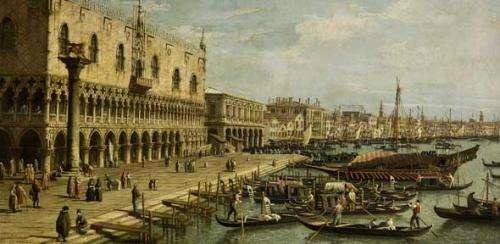The science of saving Venice

(Phys.org) —How will regions around the world adapt to an increase in sea levels? A project looking at how Venice can manage its rising waters is a remarkable case study for flood-prone environments elsewhere.
When Canaletto immortalised the waters of the Venice Lagoon beneath the steps of the Doge's Palace almost three centuries ago, he depicted water levels that have long been surpassed. Today, the water sometimes laps at brickwork above the protective stone foundations on many of the buildings and the frequency of flooding of this World Heritage Site is increasing.
A significant fraction of the world's coastlines is thought to be under threat over the next century from rising sea levels caused by climate-change-related melting of snow and ice, and thermal expansion of the oceans. How should regions plan, and how much time do they have?
One way that Venice – a city with more than five centuries of flood experience – is protecting itself is through the ongoing construction of huge barriers with hinged steel gates to seal off the three inlets that connect the Lagoon with the Adriatic Sea at times of very high water. In addition, soft engineering approaches such as replacing lost salt marshes have also been undertaken.
But, as for other regions of the world, the challenge is not one of simply trying to lessen the surge of sea water, as Professor Paul Linden explained: "Venice is a moving target. The city is sinking because of overuse of groundwater and because rerouting of rivers that once carried sediment has caused the Lagoon to deepen. Dredging to allow the passage of cruise liners stirs up sediment polluted by industry. The local ecosystems are under threat and this will be exacerbated if rising sea levels increase the salinity of the Lagoon.
"There is a growing recognition that the biology, physics and chemistry of the area are interconnected and that environmental sustainability can only be a 'whole-Lagoon' concept," added Linden, whose own research interests lie in the physics of water movement and how this is affected by climate change.
This holistic view has underpinned the work of the Venice Sustainability Advisory Panel, a 10-strong international group of scientists led by Linden and co-investigator Professor Charles Kennel (UCSD Scripps Institution of Oceanography). At the request of the Venetian authorities, the Panel worked on the question of what's needed to manage the waters and ecosystems in the Lagoon sustainably.
The team examined assessments of the ecology and physics of the Lagoon – from monitoring of habitat destruction and sediment loss through to the deepening of the Lagoon and the movement of currents – and they looked at the adequacy of current monitoring and modelling systems.
"Science was not enough," said Kennel. "It was equally crucial to take into account the social, economic and political considerations bearing upon Venice's decisions about the Lagoon."
"Venice has the talent and technology to manage this change adaptively," added Linden. "We needed to get some understanding of the capabilities and the gaps, and whether predictions are being made as to how the system will behave in the future. One of our major recommendations is the need for periodic assessments of the state of the Lagoon, and a means to ensure feedback between environmental assessments, policy decisions and management actions."
To help, they have created a 'vulnerability grid' to aid the authorities in planning a sustainable future, taking into consideration how rapidly the Lagoon is deepening, and how hot, dry and stormy the climate becomes. "The barriers might have a 100-year lifetime but what will Venice be like in 2100? We can't know for sure but the vulnerability grid can help decision makers translate assessments into vulnerabilities, and understand on what environmental trajectory the Lagoon is moving."
With the project now completed, Linden hopes that the Panel's ideas and recommendations will feed into the next set of decisions about how the flood barriers and the water flow in the Lagoon are managed once the gates are operational.
"Venice and its Lagoon illustrate the complexity of the sustainability issue and the trade-off between economic development and safeguarding the environment: any management plan first has to start with the question of what we are trying to sustain," said Linden. "Cities worldwide are strengthening their preparations against sea flooding. Each must develop its own adaptation strategy but in many ways Venice can be regarded as a 'laboratory' for activities aimed at coping with climate change and sea level rise. Venice could lead the way in connecting interdisciplinary science with practical use."
Provided by University of Cambridge

















